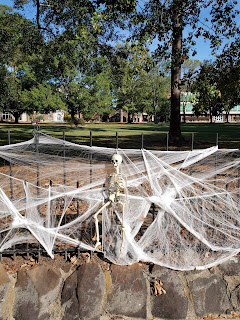Halloween or Not: Folklore and The Lady in Black
I do not have any assignments related to Halloween this semester, but my Freshman Composition class has focused on folklore readings, including an examination of Henderson State University's "Legend of the Lady in Black." I was looking for articles on folklore on college campuses and included part of a chapter on college student folklore from Richard M. Dorson's 1959 American Folklore. They were surprised by the legends about paper grading and class attendance. For example, many students believe in the fifteen-minute rule that you are excused if your professor shows up after the first fifteen minutes are over. I have never tested this one because I am usually prompt. I told them that I had often heard about the process of throwing tests and papers down the stairs and giving them grades based on how far the papers sailed when I was an undergraduate. The idea is that professors grade papers by tossing them down the stairs and determining grades based on their position on the stairs.
I was excited when I found a chapter that focused on stories of ghostly and forlorn college sweethearts in Elizabeth Tucker's 2007 book Haunted Halls: Ghostlore of American College Campuses when I was lesson planning for the semester. The chapter discusses Mansfield University in Mansfield, PA, and Henderson State. The detailed section on Henderson's "Lady in Black" delighted my students, and they opened up to tell their own stories concerning how they heard about her and the other ghosts on campus.
The "Lady in Black" comments on relationships and reflects the university's rivalry with neighboring school Ouachita Baptist University, the school across the road that has long been their football foe in the yearly Battle of the Ravine. The schools are separated by U.S. Highway 67, and players have a short walk to play against each other. The story goes that a girl from Henderson was dating a boy from Ouachita. He fell in love with another girl and broke her heart. The girl jumped from a bluff overlooking the Ouachita River to her death.
At the annual Pine Tree Speech, during orientation, and at events throughout the year, school officials and workers tell freshmen the story. They include their own experiences to frighten new students and instill school spirit. As with much folklore and urban legend, the tale grows with the telling. People add FOAF (Friend of a Friend) and explain experiences that other people have had, as well as their own. Even if they explain that they have not really experienced anything personally, the legend grows. They add elements to make the story personal, and the cycle continues each year.
The story led students to regale me with their personal experiences with ghosts and lore at the school, often interspersing stories with jokes about their residence halls and university rules. True believers and skeptics alike talked about what caused weird noises in Newberry Residence Hall. They shared stories about what they believed was real and what was false. Supposedly, there are rooms students are told not to enter and floors with more ghostly activity. These stories are similar to those I heard at other universities, and they prove folklore and storytelling is alive at colleges across the country. Telling tales helps us understand who we are as people and members of society, but it also alleviates stress at a time in the semester when papers and exams are piling up.








Comments
Post a Comment